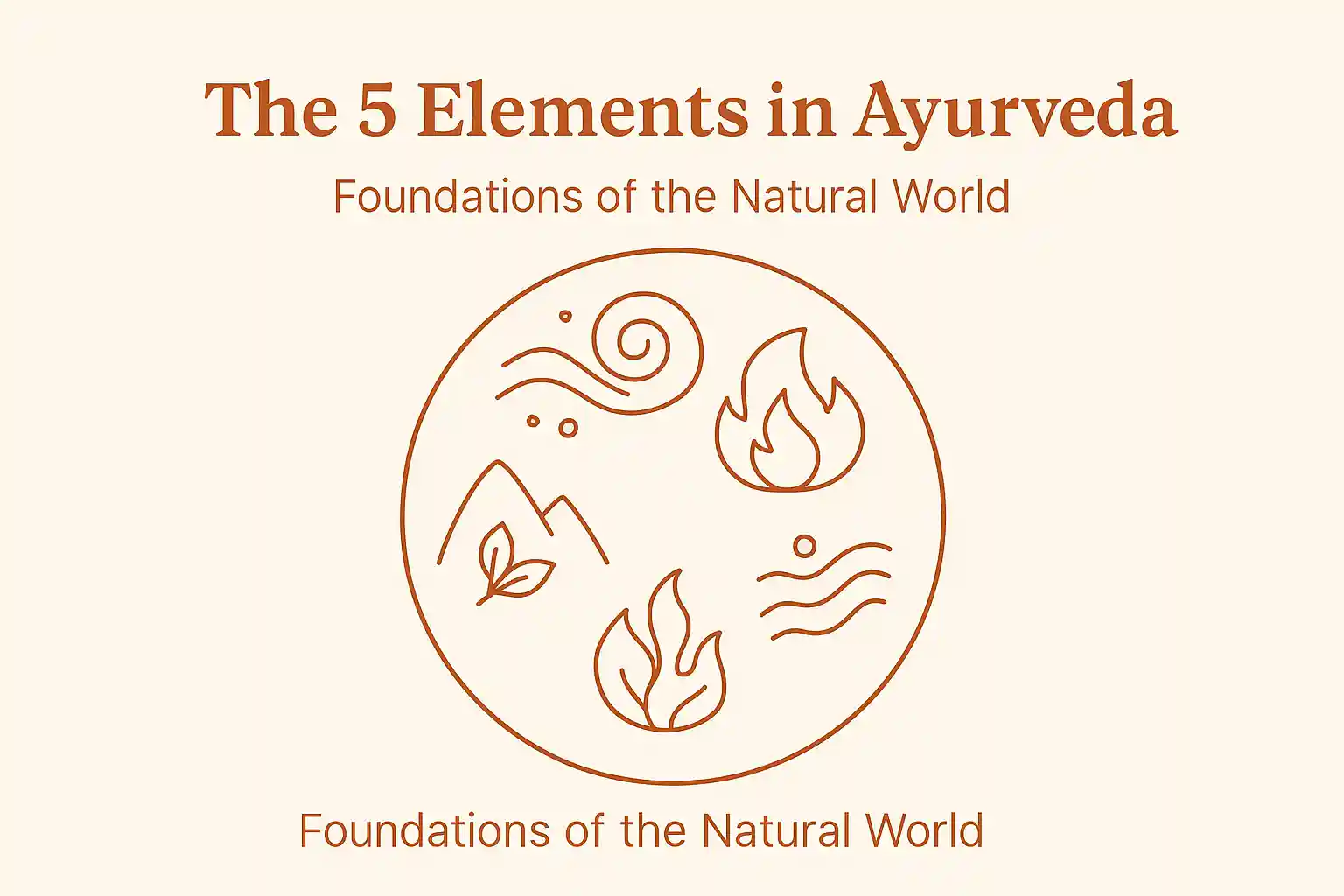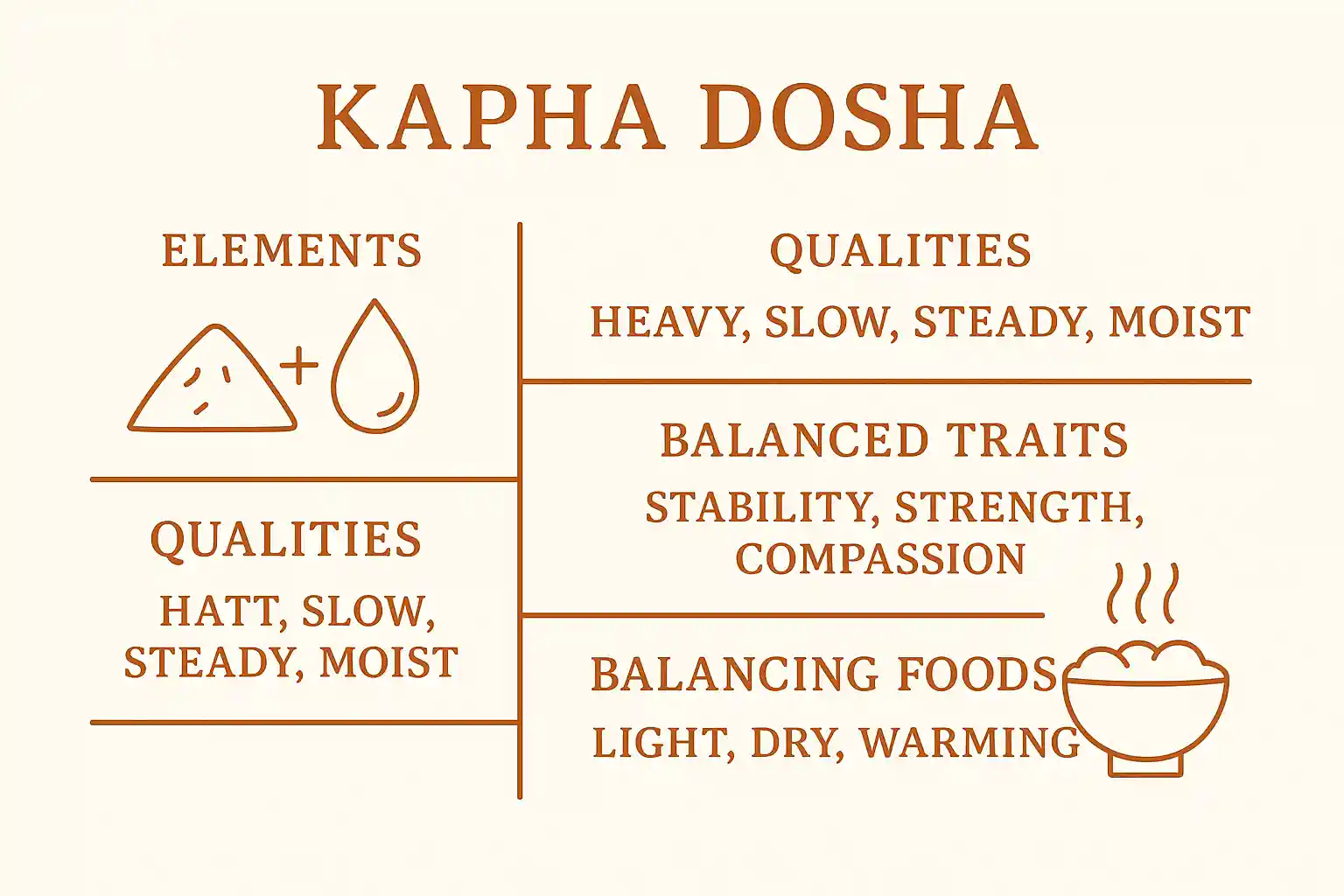
The Pancha Mahabhutas - five fundamental elements that form the foundation of Ayurvedic wisdom
Ayurveda, the traditional system of medicine from India, views all matter—including the human body—as composed of five fundamental elements: Earth (Prithvi), Water (Apas), Fire (Tejas), Air (Vayu), and Ether (Akasha). These are not chemical elements, but subtle principles that describe qualities and behaviors found in nature and in ourselves.
Understanding the Pancha Mahabhutas (Five Great Elements) is essential for grasping the Ayurvedic view of health, disease, and balance. These elements form the foundation of the Doshas, tissues (Dhatus), waste products (Malas), and all physiological processes. This framework is described extensively in classical texts such as the Charaka Samhita and Ashtanga Hridayam.
What Are the 5 Elements in Ayurveda?
Each element represents a different aspect of physical and energetic reality and is associated with one of the five senses:
| Element | Sanskrit Name | Associated Sense | Primary Quality |
|---|---|---|---|
| Ether | Akasha | Sound (hearing) | Space, openness |
| Air | Vayu | Touch (skin) | Movement, motion |
| Fire | Tejas | Sight (eyes) | Transformation, heat |
| Water | Apas | Taste (tongue) | Liquidity, cohesion |
| Earth | Prithvi | Smell (nose) | Solidity, structure |
The Five Elements in Detail
1. Ether (Akasha)
- Represents space, openness, and potential
- Governs the cavities and channels of the body
- Associated with sound and hearing
- Creates mental spaciousness and openness
2. Air (Vayu)
- Represents movement and motion
- Controls circulation and nerve impulses
- Governs all dynamic processes
- Associated with touch and skin sensation
3. Fire (Tejas)
- Represents transformation, heat, and metabolism
- Governs digestion and Agni (digestive fire)
- Controls vision and temperature regulation
- Related to light and sight
4. Water (Apas)
- Represents liquidity, cohesion, and flow
- Found in plasma, saliva, mucus, lymph
- Governs taste and fluid regulation
- Provides emotional fluidity and compassion
5. Earth (Prithvi)
- Represents solidity, structure, and stability
- Found in bones, muscles, teeth, and tissues
- Associated with smell and the nose
- Provides groundedness and mental stability
Why the Elements Matter in Ayurveda
The five elements are the building blocks of all living beings. They combine in unique proportions to form the three Doshas:
Vata Dosha
Air + Ether
Light, dry, mobile, subtle qualities
Pitta Dosha
Fire + Water
Hot, sharp, light, oily qualities
Kapha Dosha
Water + Earth
Heavy, slow, cool, stable qualities
These elemental combinations explain the physiological and psychological tendencies of each Dosha. For example, Vata types are light, dry, and mobile like Air and Ether, while Kapha types are stable and heavy like Water and Earth.
The Five Elements and the Human Body
| Element | Primary Qualities | Role in the Body |
|---|---|---|
| Ether | Subtle, expansive | Space in joints, channels, mental openness |
| Air | Dry, light, mobile | Movement of muscles, breath, thoughts |
| Fire | Hot, sharp, light | Digestion, metabolism, vision |
| Water | Cool, cohesive, fluid | Bodily fluids, lubrication, emotional softness |
| Earth | Heavy, dense, stable | Structure, bones, stamina |
Health and the Balance of Elements
Ayurveda teaches that health arises when these elements are in balance within the body and mind. When one becomes excessive or deficient, it can disturb the Doshas and lead to imbalance or disease.
Common Elemental Imbalances
- Too much Air/Ether → Vata imbalance: anxiety, dryness, constipation
- Excess Fire → Pitta imbalance: inflammation, irritability, ulcers
- Too much Earth/Water → Kapha imbalance: congestion, lethargy, weight gain
Ayurvedic treatment seeks to restore balance by adjusting diet, lifestyle, and environment to influence the elemental qualities. Strong Agni (digestive fire) helps prevent the accumulation of Ama (toxins) and supports the building of Ojas (vital essence).
The 5 Elements and the Mind
The Pancha Mahabhutas also shape our mental and emotional tendencies:
- Ether: spaciousness, openness, or emptiness
- Air: creativity, restlessness, worry
- Fire: focus, ambition, anger
- Water: compassion, attachment, moodiness
- Earth: groundedness, stability, stubbornness
Mind-body balance requires recognizing how these elemental energies express in our emotions and thoughts. They are also deeply connected to the subtle energies of Prana (life force), Tejas (metabolic intelligence), and Ojas (immunity and vitality). These three form the essence of the Doshas at a subtle level, and reflect the quality of the five elements within.
Using the Elements in Daily Life
Ayurveda offers simple, practical ways to balance the five elements:
Ether/Air (Vata)
- Warm, cooked foods
- Grounding routines
- Quiet time and meditation
- Regular sleep schedule
Fire (Pitta)
- Cooling herbs and foods
- Calming activities
- Time in nature
- Avoid overheating
Water/Earth (Kapha)
- Light exercise and movement
- Dry, warm foods
- Stimulating environments
- Regular activity and variety
Understanding the elements helps you adjust to seasons, times of day, life stages, and emotional states. Each season naturally amplifies certain elements, which is why seasonal living (Ritucharya) is so important in Ayurveda.
Frequently Asked Questions About the Five Elements
Conclusion
The Five Elements are the foundation of Ayurvedic science. They offer a profound lens through which to understand health, nature, and human behavior. By tuning into the elements within and around us, we gain tools to create harmony, resilience, and holistic well-being.
Whether you're just beginning your Ayurvedic journey or deepening your understanding, the Pancha Mahabhutas provide a timeless framework for living in balance with the natural world and your own unique constitution.
Ready to explore your elemental nature?
Sources & Further Reading
Traditional Texts
Research & Education
Related Articles

Understanding Kapha Dosha: The Foundation of Strength and Stability
Discover Kapha Dosha, the grounding force of Earth and Water elements. Learn how this vital energy provides structure, immunity, and emotional stability—and how to keep it balanced.
8 min read
Understanding the Three Doshas: Your Guide to Ayurvedic Constitution
Discover the three vital energies that govern your body and mind. Learn how understanding your unique dosha constitution can transform your approach to food, lifestyle, and daily wellness.
6 min read